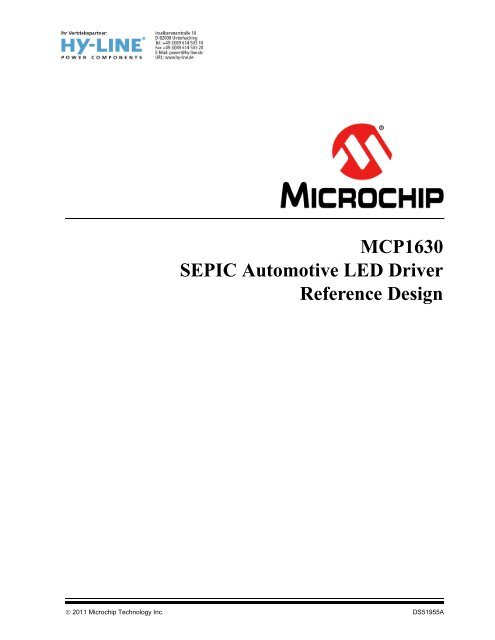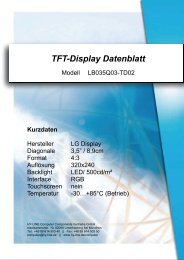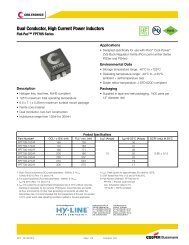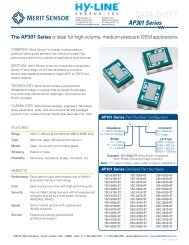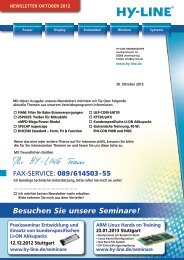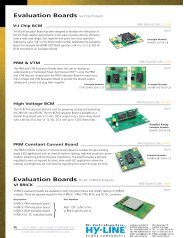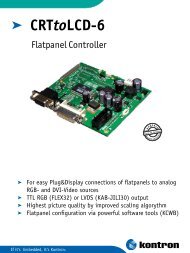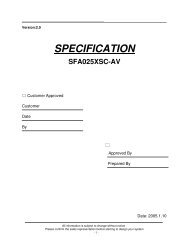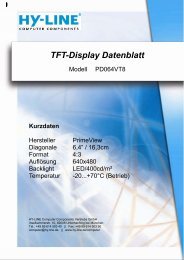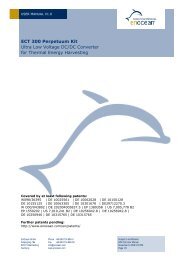MCP1630 SEPIC Automotive LED Driver Reference Design - Hy-Line
MCP1630 SEPIC Automotive LED Driver Reference Design - Hy-Line
MCP1630 SEPIC Automotive LED Driver Reference Design - Hy-Line
You also want an ePaper? Increase the reach of your titles
YUMPU automatically turns print PDFs into web optimized ePapers that Google loves.
<strong>MCP1630</strong><br />
<strong>SEPIC</strong> <strong>Automotive</strong> <strong>LED</strong> <strong>Driver</strong><br />
<strong>Reference</strong> <strong>Design</strong><br />
© 2011 Microchip Technology Inc. DS51955A
Note the following details of the code protection feature on Microchip devices:<br />
• Microchip products meet the specification contained in their particular Microchip Data Sheet.<br />
• Microchip believes that its family of products is one of the most secure families of its kind on the market today, when used in the<br />
intended manner and under normal conditions.<br />
• There are dishonest and possibly illegal methods used to breach the code protection feature. All of these methods, to our<br />
knowledge, require using the Microchip products in a manner outside the operating specifications contained in Microchip’s Data<br />
Sheets. Most likely, the person doing so is engaged in theft of intellectual property.<br />
• Microchip is willing to work with the customer who is concerned about the integrity of their code.<br />
• Neither Microchip nor any other semiconductor manufacturer can guarantee the security of their code. Code protection does not<br />
mean that we are guaranteeing the product as “unbreakable.”<br />
Code protection is constantly evolving. We at Microchip are committed to continuously improving the code protection features of our<br />
products. Attempts to break Microchip’s code protection feature may be a violation of the Digital Millennium Copyright Act. If such acts<br />
allow unauthorized access to your software or other copyrighted work, you may have a right to sue for relief under that Act.<br />
Information contained in this publication regarding device<br />
applications and the like is provided only for your convenience<br />
and may be superseded by updates. It is your responsibility to<br />
ensure that your application meets with your specifications.<br />
MICROCHIP MAKES NO REPRESENTATIONS OR<br />
WARRANTIES OF ANY KIND WHETHER EXPRESS OR<br />
IMPLIED, WRITTEN OR ORAL, STATUTORY OR<br />
OTHERWISE, RELATED TO THE INFORMATION,<br />
INCLUDING BUT NOT LIMITED TO ITS CONDITION,<br />
QUALITY, PERFORMANCE, MERCHANTABILITY OR<br />
FITNESS FOR PURPOSE. Microchip disclaims all liability<br />
arising from this information and its use. Use of Microchip<br />
devices in life support and/or safety applications is entirely at<br />
the buyer’s risk, and the buyer agrees to defend, indemnify and<br />
hold harmless Microchip from any and all damages, claims,<br />
suits, or expenses resulting from such use. No licenses are<br />
conveyed, implicitly or otherwise, under any Microchip<br />
intellectual property rights.<br />
Trademarks<br />
The Microchip name and logo, the Microchip logo, dsPIC,<br />
KEELOQ, KEELOQ logo, MPLAB, PIC, PICmicro, PICSTART,<br />
PIC 32 logo, rfPIC and UNI/O are registered trademarks of<br />
Microchip Technology Incorporated in the U.S.A. and other<br />
countries.<br />
FilterLab, Hampshire, HI-TECH C, <strong>Line</strong>ar Active Thermistor,<br />
MXDEV, MXLAB, SEEVAL and The Embedded Control<br />
Solutions Company are registered trademarks of Microchip<br />
Technology Incorporated in the U.S.A.<br />
Analog-for-the-Digital Age, Application Maestro, chipKIT,<br />
chipKIT logo, CodeGuard, dsPICDEM, dsPICDEM.net,<br />
dsPICworks, dsSPEAK, ECAN, ECONOMONITOR,<br />
FanSense, HI-TIDE, In-Circuit Serial Programming, ICSP,<br />
Mindi, MiWi, MPASM, MPLAB Certified logo, MPLIB,<br />
MPLINK, mTouch, Omniscient Code Generation, PICC,<br />
PICC-18, PICDEM, PICDEM.net, PICkit, PICtail, REAL ICE,<br />
rfLAB, Select Mode, Total Endurance, TSHARC,<br />
UniWin<strong>Driver</strong>, WiperLock and ZENA are trademarks of<br />
Microchip Technology Incorporated in the U.S.A. and other<br />
countries.<br />
SQTP is a service mark of Microchip Technology Incorporated<br />
in the U.S.A.<br />
All other trademarks mentioned herein are property of their<br />
respective companies.<br />
© 2011, Microchip Technology Incorporated, Printed in the<br />
U.S.A., All Rights Reserved.<br />
Printed on recycled paper.<br />
ISBN: 978-1-61341-606-8<br />
Microchip received ISO/TS-16949:2009 certification for its worldwide<br />
headquarters, design and wafer fabrication facilities in Chandler and<br />
Tempe, Arizona; Gresham, Oregon and design centers in California<br />
and India. The Company’s quality system processes and procedures<br />
are for its PIC ® MCUs and dsPIC ® DSCs, KEELOQ ® code hopping<br />
devices, Serial EEPROMs, microperipherals, nonvolatile memory and<br />
analog products. In addition, Microchip’s quality system for the design<br />
and manufacture of development systems is ISO 9001:2000 certified.<br />
DS51955A-page 2 © 2011 Microchip Technology Inc.
<strong>MCP1630</strong> <strong>SEPIC</strong> AUTOMOTIVE <strong>LED</strong><br />
DRIVER REFERENCE DESIGN<br />
Table of Contents<br />
Preface ........................................................................................................................... 5<br />
Introduction...............................................................................................................5<br />
Document Layout .....................................................................................................5<br />
Conventions Used in this Guide ...............................................................................6<br />
Recommended Reading...........................................................................................7<br />
The Microchip Web Site ...........................................................................................7<br />
Customer Support ....................................................................................................7<br />
Document Revision History.................................................................................... 8<br />
Chapter 1. Product Overview<br />
1.1 Introduction ........................................................................................................9<br />
1.2 Features ..........................................................................................................10<br />
1.3 Device Summary .............................................................................................10<br />
1.4 Technical Specifications ..................................................................................11<br />
1.5 Functional Description .....................................................................................12<br />
1.6 What the <strong>MCP1630</strong> <strong>SEPIC</strong> <strong>Automotive</strong> <strong>LED</strong> <strong>Driver</strong> <strong>Reference</strong> <strong>Design</strong><br />
Kit Includes ......................................................................................................... 12<br />
Chapter 2. Installation and Operation<br />
2.1 Getting Started ................................................................................................13<br />
2.2 Setup Procedure .............................................................................................13<br />
2.3 Evaluating the Application ...............................................................................15<br />
2.4 Firmware Description .......................................................................................15<br />
2.5 Programming the PIC12F683 Microcontroller ............................................... 16<br />
Appendix A. Schematic and Layouts<br />
A.1 Introduction .....................................................................................................17<br />
A.2 Board – Schematic ..........................................................................................18<br />
A.3 Board – Top Copper and Pads .......................................................................19<br />
A.4 Board – Top Copper Pads and Silk .................................................................20<br />
A.5 Board – Top Silk and Pads .............................................................................21<br />
A.6 Board – Bottom Copper and Pads ................................................................ 22<br />
Appendix B. Bill of Materials (BOM)<br />
Appendix C. Firmware Flowchart<br />
C.1 <strong>MCP1630</strong> <strong>SEPIC</strong> <strong>Automotive</strong> <strong>LED</strong> <strong>Driver</strong> <strong>Reference</strong> <strong>Design</strong><br />
Firmware Flowchart ............................................................................................ 25<br />
Appendix D. Test Points and Waveforms<br />
D.1 Test Points Description ...................................................................................27<br />
D.2 Waveforms Examples ................................................................................... 28<br />
Worldwide Sales and Service .................................................................................... 34<br />
© 2011 Microchip Technology Inc. DS51955A-page 3
<strong>MCP1630</strong> Sepic <strong>Automotive</strong> <strong>LED</strong> <strong>Driver</strong> <strong>Reference</strong> <strong>Design</strong><br />
DS51955A-page 4 © 2011 Microchip Technology Inc.
INTRODUCTION<br />
<strong>MCP1630</strong> <strong>SEPIC</strong> AUTOMOTIVE <strong>LED</strong><br />
DRIVER REFERENCE DESIGN<br />
Preface<br />
NOTICE TO CUSTOMERS<br />
All documentation becomes dated, and this manual is no exception. Microchip tools and<br />
documentation are constantly evolving to meet customer needs, so some actual dialogs<br />
and/or tool descriptions may differ from those in this document. Please refer to our web site<br />
(www.microchip.com) to obtain the latest documentation available.<br />
Documents are identified with a “DS” number. This number is located on the bottom of each<br />
page, in front of the page number. The numbering convention for the DS number is<br />
“DSXXXXXA”, where “XXXXX” is the document number and “A” is the revision level of the<br />
document.<br />
For the most up-to-date information on development tools, see the MPLAB ® IDE online help.<br />
Select the Help menu, and then Topics to open a list of available online help files.<br />
This chapter contains general information that will be useful to know before using the<br />
<strong>MCP1630</strong> <strong>SEPIC</strong> <strong>Automotive</strong> <strong>LED</strong> <strong>Driver</strong> <strong>Reference</strong> <strong>Design</strong> User’s Guide. Items<br />
discussed in this chapter include:<br />
• Document Layout<br />
• Conventions Used in this Guide<br />
• Recommended Reading<br />
• The Microchip Web Site<br />
• Customer Support<br />
• Document Revision History<br />
DOCUMENT LAYOUT<br />
This document describes how to use the <strong>MCP1630</strong> <strong>SEPIC</strong> <strong>Automotive</strong> <strong>LED</strong> <strong>Driver</strong><br />
<strong>Reference</strong> <strong>Design</strong> User’s Guide as a development tool to emulate and debug firmware<br />
on a target board. The manual layout is as follows:<br />
• Chapter 1. “Product Overview” – Important information about the <strong>MCP1630</strong><br />
<strong>SEPIC</strong> <strong>Automotive</strong> <strong>LED</strong> <strong>Driver</strong> <strong>Reference</strong> <strong>Design</strong>.<br />
• Chapter 2. “Installation and Operation” – This chapter includes a detailed<br />
description of each function of the demonstration board and instructions for how to<br />
begin using the board.<br />
• Appendix A. “Schematic and Layouts” – Shows the schematic and layout<br />
diagrams for the <strong>MCP1630</strong> <strong>SEPIC</strong> <strong>Automotive</strong> <strong>LED</strong> <strong>Driver</strong> <strong>Reference</strong> <strong>Design</strong>.<br />
• Appendix B. “Bill of Materials (BOM)” – Lists the parts used to build the<br />
<strong>MCP1630</strong> <strong>SEPIC</strong> <strong>Automotive</strong> <strong>LED</strong> <strong>Driver</strong> <strong>Reference</strong> <strong>Design</strong>.<br />
• Appendix C. “Firmware Flowchart” – Shows the board flowchart.<br />
• Appendix D. “Test Points and Waveforms” – Describes the main test points<br />
and waveforms for the <strong>MCP1630</strong> <strong>SEPIC</strong> <strong>Automotive</strong> <strong>LED</strong> <strong>Driver</strong> <strong>Reference</strong><br />
<strong>Design</strong>.<br />
© 2011 Microchip Technology Inc. DS51955A-page 5
<strong>MCP1630</strong> Sepic <strong>Automotive</strong> <strong>LED</strong> <strong>Driver</strong> <strong>Reference</strong> <strong>Design</strong><br />
CONVENTIONS USED IN THIS GUIDE<br />
This manual uses the following documentation conventions:<br />
DOCUMENTATION CONVENTIONS<br />
Description<br />
Arial font:<br />
Represents Examples<br />
Italic characters <strong>Reference</strong>d books MPLAB ® IDE User’s Guide<br />
Emphasized text ...is the only compiler...<br />
Initial caps A window the Output window<br />
A dialog the Settings dialog<br />
A menu selection select Enable Programmer<br />
Quotes A field name in a window or<br />
dialog<br />
“Save project before build”<br />
Underlined, italic text with<br />
right angle bracket<br />
A menu path File>Save<br />
Bold characters A dialog button Click OK<br />
A tab Click the Power tab<br />
N‘Rnnnn A number in verilog format,<br />
where N is the total number of<br />
digits, R is the radix and n is a<br />
digit.<br />
4‘b0010, 2‘hF1<br />
Text in angle brackets < ><br />
Courier New font:<br />
A key on the keyboard Press , <br />
Plain Courier New Sample source code #define START<br />
Filenames autoexec.bat<br />
File paths c:\mcc18\h<br />
Keywords _asm, _endasm, static<br />
Command-line options -Opa+, -Opa-<br />
Bit values 0, 1<br />
Constants 0xFF, ‘A’<br />
Italic Courier New A variable argument file.o, where file can be<br />
any valid filename<br />
Square brackets [ ] Optional arguments mcc18 [options] file<br />
[options]<br />
Curly brackets and pipe Choice of mutually exclusive errorlevel {0|1}<br />
character: { | }<br />
arguments; an OR selection<br />
Ellipses... Replaces repeated text var_name [,<br />
var_name...]<br />
Represents code supplied by void main (void)<br />
user<br />
{ ...<br />
}<br />
DS51955A-page 6 © 2011 Microchip Technology Inc.
RECOMMENDED READING<br />
THE MICROCHIP WEB SITE<br />
CUSTOMER SUPPORT<br />
Preface<br />
This user’s guide describes how to use the <strong>MCP1630</strong> <strong>SEPIC</strong> <strong>Automotive</strong> <strong>LED</strong> <strong>Driver</strong><br />
<strong>Reference</strong> <strong>Design</strong> User’s Guide. Other useful documents are listed below. The following<br />
Microchip documents are available and recommended as supplemental reference<br />
resources.<br />
• <strong>MCP1630</strong>/<strong>MCP1630</strong>V Data Sheet – “High-Speed, Microcontroller-Adaptable,<br />
Pulse Width Modulator” (DS21896)<br />
• PIC12F683 Data Sheet – “8-Pin Flash-Based, 8-Bit CMOS Microcontrollers<br />
with nanoWatt Technology” (DS41211)<br />
• MCP1790 Data Sheet – “70 mA, High Voltage Regulator” (DS22075)<br />
• MCP1415/16 Data Sheet – “Tiny 1.5A, High-Speed Power MOSFET <strong>Driver</strong>”<br />
(DS22092)<br />
• AN1137 – “Using the MCP1631 Family to Develop Low-Cost<br />
Battery Chargers” (DS01137)<br />
Microchip provides online support via our web site at www.microchip.com. This web<br />
site is used as a means to make files and information easily available to customers.<br />
Accessible by using your favorite Internet browser, the web site contains the following<br />
information:<br />
• Product Support – Data sheets and errata, application notes and sample<br />
programs, design resources, user’s guides and hardware support documents,<br />
latest software releases and archived software<br />
• General Technical Support – Frequently Asked Questions (FAQs), technical<br />
support requests, online discussion groups, Microchip consultant program<br />
member listing<br />
• Business of Microchip – Product selector and ordering guides, latest Microchip<br />
press releases, listing of seminars and events, listings of Microchip sales offices,<br />
distributors and factory representatives<br />
Users of Microchip products can receive assistance through several channels:<br />
• Distributor or Representative<br />
• Local Sales Office<br />
• Field Application Engineer (FAE)<br />
• Technical Support<br />
Customers should contact their distributor, representative or field application engineer<br />
(FAE) for support. Local sales offices are also available to help customers. A listing of<br />
sales offices and locations is included in the back of this document.<br />
Technical support is available through the web site at: http://support.microchip.com<br />
© 2011 Microchip Technology Inc. DS51955A-page 7
<strong>MCP1630</strong> Sepic <strong>Automotive</strong> <strong>LED</strong> <strong>Driver</strong> <strong>Reference</strong> <strong>Design</strong><br />
DOCUMENT REVISION HISTORY<br />
Revision A (September 2011)<br />
• Initial Release of this Document.<br />
DS51955A-page 8 © 2011 Microchip Technology Inc.
1.1 INTRODUCTION<br />
<strong>MCP1630</strong> <strong>SEPIC</strong> AUTOMOTIVE <strong>LED</strong><br />
DRIVER REFERENCE DESIGN<br />
Chapter 1. Product Overview<br />
The <strong>MCP1630</strong> Sepic <strong>Automotive</strong> <strong>LED</strong> <strong>Driver</strong> <strong>Reference</strong> <strong>Design</strong> is a step-up/down,<br />
Switch mode, DC-DC converter used for powering <strong>LED</strong> applications. The demo board<br />
provides a 350 mA (700 mA, with hardware modification) constant current source.<br />
Other output currents can be obtained with minor modifications to the board<br />
components’ values.<br />
The <strong>MCP1630</strong> Sepic <strong>Automotive</strong> <strong>LED</strong> <strong>Driver</strong> <strong>Reference</strong> <strong>Design</strong> sustains the<br />
high-voltage peaks that can be found in typical automotive applications. This board<br />
provides useful information about typical high-voltage applications that can be found in<br />
the automotive field.<br />
The <strong>MCP1630</strong> Sepic <strong>Automotive</strong> <strong>LED</strong> <strong>Driver</strong> <strong>Reference</strong> <strong>Design</strong> utilizes Microchip’s<br />
<strong>MCP1630</strong> high-speed, Pulse-Width Modulator (PWM) device. The 8-pin <strong>MCP1630</strong><br />
device contains all the analog components necessary for a peak current switch-mode<br />
control loop, including an error amplifier, a PWM comparator and a high-current driver<br />
output pin. The switching frequency and the maximum duty cycle for the <strong>MCP1630</strong> are<br />
determined by an external clock source.<br />
An 8-pin PIC12F683 microcontroller is used to provide a 330 kHz switching clock for<br />
the <strong>MCP1630</strong> device. In addition, the PIC12F683 firmware supervises the input and<br />
output voltage, and can optionally dim the <strong>LED</strong>s when a button is attached.<br />
In this reference design, the <strong>MCP1630</strong> device is used for Peak Current Mode Control<br />
in a <strong>SEPIC</strong> power train circuit. Because the duty cycle exceeds 50%, a ramp generator<br />
provides an additional reference signal to the <strong>MCP1630</strong> for slope compensation.<br />
Note: This application uses a Peak Current Mode Control. Use only the <strong>MCP1630</strong><br />
device option for this board.<br />
© 2011 Microchip Technology Inc. DS51955A-page 9
<strong>MCP1630</strong> Sepic <strong>Automotive</strong> <strong>LED</strong> <strong>Driver</strong> <strong>Reference</strong> <strong>Design</strong><br />
1.2 FEATURES<br />
1.3 DEVICE SUMMARY<br />
The <strong>MCP1630</strong> Sepic <strong>Automotive</strong> <strong>LED</strong> <strong>Driver</strong> <strong>Reference</strong> <strong>Design</strong> has the following<br />
features:<br />
• Compact size with high output power<br />
• Can operate in Buck (step-down) or Boost (step-up) mode<br />
• Sustains voltage stresses typically found in automotive products:<br />
42 VIN for 180 ms<br />
• High efficiency over the entire operating input and output voltage ranges:<br />
85% typical<br />
• Maximum Output Current = 350 mA; this value can be modified with minor<br />
changes in hardware<br />
• Maximum Output Power = 18W<br />
• Optional software dimming control for both methods: PWM or Current mode<br />
• Preprogrammed source code<br />
• The switching frequency, maximum duty cycle and the <strong>MCP1630</strong> reference<br />
voltage can be modified in firmware<br />
• Additional application functions can be implemented in firmware<br />
The <strong>MCP1630</strong> Sepic <strong>Automotive</strong> <strong>LED</strong> <strong>Driver</strong> <strong>Reference</strong> <strong>Design</strong> uses the following<br />
devices:<br />
• <strong>MCP1630</strong> High-Speed Pulse-Width Modulator IC – When used in conjunction with<br />
a microcontroller, the <strong>MCP1630</strong> controls the power system duty cycle to provide<br />
output current and/or voltage regulation.<br />
• PIC12F683 Microcontroller (8-bit MCU) – Used to generate the <strong>MCP1630</strong>’s<br />
reference voltage, the oscillator signal at 330 kHz, and to provide additional<br />
software functions.<br />
• MCP1790 HV LDO Regulator – Used to supply the regulated voltage to the<br />
PIC12F683 and <strong>MCP1630</strong>. The MCP1790 is capable of delivering 70 mA and<br />
sustaining 42V surge voltage on input for 180 ms (30 seconds repetition rate).<br />
• MCP1416 – Is a high-speed MOSFET driver, capable of providing 1.5A of peak<br />
current for driving the switching power transistor.<br />
DS51955A-page 10 © 2011 Microchip Technology Inc.
1.4 TECHNICAL SPECIFICATIONS<br />
Ramp Generator<br />
Slope Compensation<br />
Circuit<br />
Product Overview<br />
• Input Voltage = 9V to 16V (surge voltage of 42V for maximum 180 ms, 30 seconds<br />
repetition rate)<br />
• Software Configurable Under Voltage Lock-Out Circuit (UVLO) and Over Voltage<br />
Lock-Out Circuit (OVLO) (8V and 17V default thresholds)<br />
• Software Configurable Load Disconnect Protection<br />
• Typical Output Current = 350 mA<br />
• Maximum Output Current = 700 mA (with hardware modifications)<br />
• Typical Output Power = 18W (maximum 20W at TA = +25°C)<br />
• Fully Protected Against Short-Circuit and No-Load Condition<br />
Figure 1-1 shows a simplified block diagram of the application.<br />
+5V<br />
4 OSC<br />
5 GND<br />
1<br />
COMP<br />
+5V<br />
PWM<br />
COMP<br />
MCP1790<br />
OUT IN<br />
GND<br />
7<br />
<strong>MCP1630</strong><br />
EA<br />
OUTPUT<br />
DRIVER<br />
Compensation Network<br />
FIGURE 1-1: <strong>MCP1630</strong> Sepic <strong>Automotive</strong> <strong>LED</strong> <strong>Driver</strong> <strong>Reference</strong> <strong>Design</strong> Block Diagram.<br />
V EXT<br />
6<br />
CS<br />
3<br />
FB<br />
2<br />
REF<br />
8<br />
1<br />
CLOCK VDD 5 GP2<br />
GP5<br />
2<br />
<strong>Reference</strong><br />
Voltage Filter<br />
Aux. 4 GP3<br />
GP1 6<br />
Dimming 7<br />
GP0<br />
GP4 3 VIN Sense<br />
VSS 8<br />
PIC12F683<br />
MCP1416<br />
MOSFET<br />
<strong>Driver</strong><br />
© 2011 Microchip Technology Inc. DS51955A-page 11<br />
CS<br />
Surge<br />
Protection<br />
<strong>SEPIC</strong> Power Train<br />
I SENSE<br />
<strong>LED</strong> String<br />
+V IN<br />
V IN Sense<br />
Current<br />
Sense<br />
Resistor
<strong>MCP1630</strong> Sepic <strong>Automotive</strong> <strong>LED</strong> <strong>Driver</strong> <strong>Reference</strong> <strong>Design</strong><br />
1.5 FUNCTIONAL DESCRIPTION<br />
The <strong>MCP1630</strong> device provides all the analog functions necessary to implement a Peak<br />
Current Mode PWM DC-DC Converter. The power train is based on the Single-Ended<br />
Primary Inductor Converter (<strong>SEPIC</strong>) topology. This topology offers the buck-boost<br />
functionality and also has non-pulsating input current.<br />
The converter provides adjustable constant current at the output, necessary to drive<br />
high-power <strong>LED</strong> applications.<br />
The <strong>MCP1630</strong> PWM controller requires an external clock for operation. This clock is<br />
provided by an external 8-bit microcontroller, PIC12F683. The PWM frequency and the<br />
maximum duty cycle are set by this clock.<br />
The output (load) current is sensed with a 0.5Ω shunt resistor (R17 and R18). The<br />
voltage across this shunt resistor is compared with the reference voltage by the<br />
<strong>MCP1630</strong> device’s PWM controller.<br />
The reference voltage for the <strong>MCP1630</strong> device is also provided by PIC12F683, at the<br />
VREF pin (Pin 8). R4, R3 and C2 form a low-pass filter that smooths the PWM signal<br />
produced by the PIC ® microcontroller. The maximum output current is set by the R4<br />
and R3 voltage dividers. The duty cycle of the PWM signal is adjusted in eight steps.<br />
The output current is calculated with Equation 1-1:<br />
EQUATION 1-1:<br />
Where:<br />
I OUT<br />
V REFmax<br />
I OUTmax<br />
VREF -----------<br />
0.5<br />
Because the operating duty cycle is bigger than 50%, a slope compensation circuit is<br />
required to avoid subharmonic oscillations that occur in Peak Current mode controllers.<br />
A ramp generator is constructed with Q1 and the associated components. The ramp is<br />
then summed with the inductor current, measured across R9 and R10 resistors.<br />
A 100V VDS MOSFET transistor is also used in this application. The MCP1416<br />
MOSFET driver drives the gate of this transistor. This is necessary because the<br />
high-voltage transistors usually have high gate charge and also require at least 7V for<br />
gate-to-source voltage.<br />
1.6 WHAT THE <strong>MCP1630</strong> <strong>SEPIC</strong> AUTOMOTIVE <strong>LED</strong> DRIVER REFERENCE<br />
DESIGN KIT INCLUDES<br />
The <strong>MCP1630</strong> Sepic <strong>Automotive</strong> <strong>LED</strong> <strong>Driver</strong> <strong>Reference</strong> <strong>Design</strong> includes:<br />
• <strong>MCP1630</strong> Sepic <strong>Automotive</strong> <strong>LED</strong> <strong>Driver</strong> <strong>Reference</strong> <strong>Design</strong> (102-00323)<br />
• Important Information Sheet<br />
DS51955A-page 12 © 2011 Microchip Technology Inc.<br />
=<br />
R3<br />
= ⎛-------------------- ⎞<br />
⎝R3 + R4⎠<br />
× 5V= 178mV<br />
178mV<br />
= ---------------- = 357 m A<br />
0.5<br />
Note: The MCP1416 MOSFET driver must be protected against input voltage<br />
surges. This protection is ensured by R6 and D1.
2.1 GETTING STARTED<br />
2.2 SETUP PROCEDURE<br />
<strong>MCP1630</strong> <strong>SEPIC</strong> AUTOMOTIVE <strong>LED</strong><br />
DRIVER REFERENCE DESIGN<br />
Chapter 2. Installation and Operation<br />
The <strong>MCP1630</strong> Sepic <strong>Automotive</strong> <strong>LED</strong> <strong>Driver</strong> <strong>Reference</strong> <strong>Design</strong> is fully assembled and<br />
tested. The board requires the use of an external input voltage source (9V to 16V) and<br />
an external <strong>LED</strong> load, provided by Microchip.<br />
2.1.1 Additional Tools Required for Operation<br />
1. A DC power supply, a bench supply that can produce 12V, 2.5A, is recommended<br />
to operate the board at the full rated power.<br />
2. An oscilloscope and/or a multi-meter to observe the waveforms and measure the<br />
electrical parameters (optional).<br />
To operate the <strong>MCP1630</strong> Sepic <strong>Automotive</strong> <strong>LED</strong> <strong>Driver</strong> <strong>Reference</strong> <strong>Design</strong>, the<br />
following steps must be completed:<br />
1. Attach an <strong>LED</strong> load (or dummy load) to the Output Connector J3 (observe the<br />
polarity).<br />
2. Attach the push button to the J1 header (between Pins 3 and 4 is optional).<br />
3. Connect a power supply to the Input Connector J2 (observe the polarity).<br />
Detailed instructions are provided below for each step.<br />
2.2.1 Demo Board Output Current Configuration<br />
The board is configured to deliver a maximum of 350 mA to the <strong>LED</strong>s’ load. UVLO and<br />
OVLO thresholds are set to 8V and 17V, respectively. The maximum output voltage is<br />
set to be approximately 55V.<br />
2.2.2 Connecting the Load<br />
WARNING<br />
Please observe the polarity for all steps to avoid board damage.<br />
A string of up to sixteen white <strong>LED</strong>s (1W each) can be powered by this board. The<br />
<strong>LED</strong>'s string must be mounted on an appropriate heat sink to keep the maximum<br />
junction temperature at safe level (consult the <strong>LED</strong> data sheet for details). The<br />
maximum current delivered by the board to the <strong>LED</strong>'s string is set to 350mA and the<br />
maximum output voltage is 55V.<br />
The <strong>LED</strong>'s string can be replaced by a resistor of 150Ω and 20W dissipated power<br />
(dummy load). In this case, the power delivered to the load will be about 18W.<br />
Connect the <strong>LED</strong>s’ string to the J3 connector. It is very important to use the correct<br />
polarity (see Figure 2-1).<br />
© 2011 Microchip Technology Inc. DS51955A-page 13
<strong>MCP1630</strong> Sepic <strong>Automotive</strong> <strong>LED</strong> <strong>Driver</strong> <strong>Reference</strong> <strong>Design</strong><br />
+VIN GND<br />
FIGURE 2-1: Power Supply and Load Connection Diagram.<br />
2.2.3 Connecting the Dimming Push Button (optional)<br />
The Dimming Push Button provides the option to adjust the <strong>LED</strong>s’ luminous intensity<br />
in eight steps. Connect the Dimming Push Button to the J1 header between GND<br />
(Pin 3) and Pin 4.<br />
2.2.4 Powering the Board<br />
(+)LOAD<br />
(-)LOAD<br />
Connect a<br />
push button<br />
between<br />
Pin 3 and<br />
Pin 4<br />
Connect a power supply to J2 to power up the <strong>MCP1630</strong> Sepic <strong>Automotive</strong> <strong>LED</strong> <strong>Driver</strong><br />
<strong>Reference</strong> <strong>Design</strong>. Ensure that the power supply has the (+) terminal connected to the<br />
J2 terminal block at Pin 1 (left), and the (–) terminal connected to Pin 2 (right). The input<br />
voltage source should be limited to a range from 9V to 16V. Ensure that the chosen<br />
power supply can provide enough current at the selected voltage to properly power the<br />
<strong>LED</strong>s.<br />
For 12V input voltage, the current drain will be around 1.8A at full load (18W).<br />
Note: This board has no Thermal Shut-Down function implemented. Please<br />
ensure that the load is properly cooled.<br />
DS51955A-page 14 © 2011 Microchip Technology Inc.
2.2.5 Using the <strong>Reference</strong> Board<br />
Installation and Operation<br />
When the board is powered up, it supplies the maximum output current (350mA). The<br />
user has the option to adjust this output current connecting an external push button<br />
(see Figure 2-1). The push button controls the output current in eight steps from 0 to<br />
350mA.<br />
The board has Under Voltage Lock-Out and Over Voltage Lock-Out protections. The<br />
thresholds are set in firmware and are 8 VDC and 17 VDC , respectively.<br />
The board is protected for the No-Load condition. The typical threshold value is 55 VDC for the output voltage.<br />
2.3 EVALUATING THE APPLICATION<br />
The best way to evaluate the <strong>MCP1630</strong> Sepic <strong>Automotive</strong> <strong>LED</strong> <strong>Driver</strong> <strong>Reference</strong><br />
<strong>Design</strong> is to dig into the circuit and measure the voltages and currents with a Digital<br />
Voltage Meter (DVM), and probe the board with an oscilloscope.<br />
Additional tools are necessary to evaluate some technical parameters of the board<br />
(temperature of power components, ability to withstand surge voltage pulse on input,<br />
EMI).<br />
Some typical voltage and waveforms are provided in Appendix D. “Test Points and<br />
Waveforms”.<br />
The firmware program of the PIC12F683 can also be edited to modify the operation of<br />
the application.<br />
2.4 FIRMWARE DESCRIPTION<br />
Note: It is not recommended to operate the board without a proper load<br />
connected to the output. The maximum power at the output must be limited<br />
to 19W at ambient temperature.<br />
The PIC12F683 is preprogrammed with firmware to operate the system, as described<br />
in the previous sections. The firmware flow diagram is shown in Appendix<br />
C. “Firmware Flowchart”. The program is simple and straightforward.<br />
The TRISIO register controls the direction of the GPIO pins, and is configured to set<br />
GP2 (oscillator pulses to the <strong>MCP1630</strong>) and GP5 (VREF voltage to <strong>MCP1630</strong>) as output<br />
ports. GP1 and GP4 are configured as analog inputs. These inputs are used to<br />
measure the input and output voltages.<br />
The Capture/Compare/PWM (CCP) block is used to generate the master clock for the<br />
<strong>MCP1630</strong> device. This module is configured for PWM mode operation. The PWM<br />
period can be calculated by writing to the PR2 register. The PWM duty cycle is specified<br />
by writing to the CCPR1L register and to the CCP1CON bits. A resolution, up to<br />
10-bit, is available. The CCPR1L contains the eight MSbs, while the CCP1CON<br />
contains the two LSbs. This 10-bit value is represented by the<br />
CCPR1L:CCP1CON bits. The switching frequency is set to 330 kHz.<br />
The reference voltage for the <strong>MCP1630</strong> device is produced by the software PWM. This<br />
allows the user to adjust the <strong>LED</strong>’s intensity in eight steps.<br />
The No-Load condition protection is provided by using the internal comparator. If the<br />
output voltage is too high, an interrupt occurs and the master clock for PWM operation<br />
is disabled.<br />
The internal ADC is used to monitor the input voltage. If the input voltage is too low or<br />
too high, the board will be in a “Power Off” condition.<br />
The Soft Start feature is also provided in this firmware. The duty cycle is gradually<br />
increased until it reaches the maximum value.<br />
© 2011 Microchip Technology Inc. DS51955A-page 15
<strong>MCP1630</strong> Sepic <strong>Automotive</strong> <strong>LED</strong> <strong>Driver</strong> <strong>Reference</strong> <strong>Design</strong><br />
2.5 PROGRAMMING THE PIC12F683 MICROCONTROLLER<br />
The firmware package provides the source and .hex files for the <strong>LED</strong> driver.<br />
The board is factory programmed with the <strong>LED</strong> driver firmware. UVLO, OVLO<br />
thresholds and dimming steps can be modified. The source code is commented<br />
extensively and helps the user to define the board.<br />
This firmware was developed using MPLAB ® Integrated Development Environment<br />
and HI-TECH C ® for the PIC10/12/16 MCU Family (v9.7).<br />
Header J1 provides in-system circuit programming. Follow the next steps to program<br />
the board:<br />
1. Connect the PICkit 3 to the USB port.<br />
2. Connect the PICkit 3 device to the board at J1 pin. Ensure the polarity is correctly<br />
applied.<br />
3. Open the project00323.prj file with MPLAB Integrated Development<br />
Environment.<br />
4. Select Programmer from the menu bar, click Select Programmer and choose<br />
PICkit 3 from the submenu list.<br />
5. Return to the Programmer menu and select Settings. From the Properties<br />
window that appears, click the Power tab.<br />
Set the voltage to 5V and select the “Power target circuit from PICkit 3” check<br />
box. Press Apply.<br />
6. On the warning message that appears click, OK.<br />
7. From the Programmer menu, choose Program. Check the Output window if the<br />
programming was performed without errors.<br />
The board is now ready to operate.<br />
DS51955A-page 16 © 2011 Microchip Technology Inc.
A.1 INTRODUCTION<br />
<strong>MCP1630</strong> <strong>SEPIC</strong> AUTOMOTIVE <strong>LED</strong><br />
DRIVER REFERENCE DESIGN<br />
Appendix A. Schematic and Layouts<br />
This appendix contains the following schematics and layouts for the <strong>MCP1630</strong> Sepic<br />
<strong>Automotive</strong> <strong>LED</strong> <strong>Driver</strong> <strong>Reference</strong> <strong>Design</strong> User’s Guide:<br />
• Board – Schematic<br />
• Board – Top Copper and Pads<br />
• Board – Top Copper Pads and Silk<br />
• Board – Top Silk and Pads<br />
• Board – Bottom Copper and Pads<br />
© 2011 Microchip Technology Inc. DS51955A-page 17
<strong>MCP1630</strong> Sepic <strong>Automotive</strong> <strong>LED</strong> <strong>Driver</strong> <strong>Reference</strong> <strong>Design</strong><br />
A.2 BOARD – SCHEMATIC<br />
TP8<br />
VIN-<br />
TP7<br />
VIN+<br />
U4<br />
MCP1790<br />
TP4<br />
+5V<br />
IN<br />
J2<br />
1 1<br />
2 2<br />
OUT IN<br />
+5V<br />
R11<br />
91K<br />
C12<br />
10u<br />
C11<br />
10u<br />
GND<br />
R6<br />
68/1W<br />
C7<br />
4.7u<br />
C6<br />
100N<br />
C3<br />
100N<br />
+VIN_SENSE<br />
L1<br />
22uH<br />
R12<br />
10K<br />
SLOPE COMPENSATION CKT.<br />
+5V<br />
TP9<br />
VOUT+<br />
SMAZ15-13-F<br />
D1<br />
C8<br />
1U<br />
TP3<br />
CS<br />
TP1<br />
SLOPE<br />
R1<br />
5.1K<br />
J3<br />
1<br />
1<br />
2<br />
2 OUT<br />
D2<br />
C10<br />
R2<br />
DRAIN<br />
TP6<br />
Q1<br />
NDS7002A<br />
10BQ100<br />
2.2u/100V<br />
R5<br />
C4<br />
2K7<br />
C1<br />
1500P<br />
TP10<br />
ISENSE<br />
10K<br />
1500P<br />
OSC<br />
R16<br />
R13<br />
15K<br />
C14<br />
2.2u<br />
C13<br />
2.2u<br />
L2<br />
22uH<br />
TP5<br />
DRIVE<br />
MCP1416<br />
U3<br />
2<br />
VDD<br />
U1<br />
ISENSE<br />
1<br />
Comp<br />
10K<br />
Q2<br />
BSC196N10NSG<br />
R18<br />
1<br />
R17<br />
1<br />
DS51955A-page 18 © 2011 Microchip Technology Inc.<br />
R8<br />
R7<br />
3 5<br />
IN OUT<br />
NC 1<br />
GND<br />
4<br />
FB<br />
2<br />
ISENSE<br />
6<br />
VEXT<br />
VIN<br />
7<br />
+5V<br />
TP2<br />
OSC<br />
3<br />
CS<br />
OSC IN<br />
4<br />
1K<br />
1K<br />
R10<br />
0.22<br />
R9<br />
0.22<br />
C9<br />
22P<br />
5<br />
8 VREF<br />
GND<br />
VREF<br />
R15<br />
62K<br />
<strong>MCP1630</strong><br />
R3<br />
100k<br />
C2<br />
1U<br />
OVP<br />
C15<br />
470P<br />
R14<br />
3.3K<br />
U2<br />
VREF = lout X Rsense<br />
Rsense = 0.5<br />
8<br />
1<br />
VSS<br />
VDD<br />
+5V<br />
+5V<br />
7<br />
2<br />
R4<br />
PROGRAMMING HEADER<br />
DIMMING<br />
J1<br />
1<br />
2<br />
3<br />
4<br />
5<br />
GP0/AN0/CIN+/ICSPDAT/ULPWU<br />
GP5/TICKI/OSC1/CLKIN<br />
VREF<br />
2M7<br />
6<br />
GP1/AN1/CIN-/VREF/ICSPCLK<br />
3 GP4/AN3/OSC2/CLKOUT<br />
+VIN_SENSE<br />
OSC<br />
5<br />
GP2/AN2/T0CKI/INT/COUT/CCP1<br />
GP3/MCLR/VPP<br />
4<br />
C5<br />
470P<br />
PIC12F683
A.3 BOARD – TOP COPPER AND PADS<br />
Schematic and Layouts<br />
© 2011 Microchip Technology Inc. DS51955A-page 19
<strong>MCP1630</strong> Sepic <strong>Automotive</strong> <strong>LED</strong> <strong>Driver</strong> <strong>Reference</strong> <strong>Design</strong><br />
A.4 BOARD – TOP COPPER PADS AND SILK<br />
DS51955A-page 20 © 2011 Microchip Technology Inc.
A.5 BOARD – TOP SILK AND PADS<br />
Schematic and Layouts<br />
© 2011 Microchip Technology Inc. DS51955A-page 21
<strong>MCP1630</strong> Sepic <strong>Automotive</strong> <strong>LED</strong> <strong>Driver</strong> <strong>Reference</strong> <strong>Design</strong><br />
A.6 BOARD – BOTTOM COPPER AND PADS<br />
DS51955A-page 22 © 2011 Microchip Technology Inc.
<strong>MCP1630</strong> <strong>SEPIC</strong> AUTOMOTIVE <strong>LED</strong><br />
DRIVER REFERENCE DESIGN<br />
Appendix B. Bill of Materials (BOM)<br />
TABLE B-1: BILL OF MATERIALS (BOM)<br />
Qty <strong>Reference</strong> Description Manufacturer Part Number<br />
4 B1, B2, B3, B4 BUMPON HEMISPHERE .44X.20<br />
CLEAR<br />
2 C1,C4 CAPACITOR 1500P 50V COG 5%<br />
SMD 0805<br />
1 C2 CAPACITOR 1U 16V X7R 10%<br />
SMD 0805<br />
2 C3, C6 CAPACITOR 100N 100V X7R 10%<br />
SMD 0805<br />
2 C5, C15 CAPACITOR 470P 50V COG 5%<br />
SMD 0805<br />
1 C7 CAPACITOR 4.7U 10V X7R 10%<br />
SMD 0805<br />
1 C8 CAPACITOR 1U 25V X7R 10%<br />
SMD 0805<br />
1 C9 CAPACITOR 22P 50V COG 5%<br />
SMD 0805<br />
3 C10, C13, C14 CAPACITOR 2.2U 100V X7R 10%<br />
SMD 1210<br />
2 C11, C12 CAPACITOR 10U 25V X7R 10%<br />
SMD 1210<br />
1 D1 SMAZ15-13-F DIODE ZENNER<br />
15V/1W SMD SMA<br />
1 D2 10BQ100 DIODE SCHOTTKY 100V<br />
1A SMB<br />
1 J1 CONN HEADER 5POS .100 VERT<br />
TIN<br />
3M SJ-5303 (CLEAR)<br />
KEMET ®<br />
C0805C152J5GACTU<br />
KEMET C0805C105K4RACTU<br />
KEMET C0805C104K1RACTU<br />
KEMET C0805C471J5GACTU<br />
TAIYO YUDEN Co., Ltd. LMK212B7475KG-T<br />
KEMET C0805C105K3RACTU<br />
KEMET C0805C220J5GACTU<br />
KEMET C1210C225K1R1C<br />
KEMET C1210X106K3RACTU<br />
Diodes Incorporated ®<br />
Vishay<br />
Intertechnology, Inc.<br />
SMAZ15-13-F<br />
10BQ100TRPBF<br />
Molex ® Connector Corp. 22-03-2051<br />
2 J2, J3 CONN TERM BLOCK 2.54MM 2POS Phoenix Contact 1725656<br />
2 L1, L2 INDUCTOR POWER 22UH 6.0A<br />
SMD<br />
Wurth ® Group 7443551221<br />
1 PCB RoHS Compliant Bare PCB,<br />
<strong>MCP1630</strong> <strong>SEPIC</strong> <strong>Automotive</strong> <strong>LED</strong><br />
<strong>Driver</strong> <strong>Reference</strong> <strong>Design</strong><br />
— 104-00323<br />
1 Q1 NDS7002A MOSFET N-CH 60V Fairchild<br />
280MA SOT-23<br />
Semiconductor ®<br />
NDS7002A<br />
1 Q2 BSC196N10NS G MOSFET N-CH Infineon<br />
BSC196N10NS G<br />
100V 45A TDSON-8<br />
Technologies AG<br />
1 R1 RESISTOR 5.1K OHM 1/8W 1% Vishay<br />
CRCW08055K10FKEA<br />
SMD 0805<br />
Intertechnology, Inc.<br />
1 R2 RESISTOR 2.7K OHM 1/8W 1% Vishay<br />
CRCW08052K70FKEA<br />
SMD 0805<br />
Intertechnology, Inc.<br />
Note 1: The components listed in this Bill of Materials are representative of the PCB assembly. The released<br />
BOM used in manufacturing uses all RoHS-compliant components.<br />
© 2011 Microchip Technology Inc. DS51955A-page 23
<strong>MCP1630</strong> Sepic <strong>Automotive</strong> <strong>LED</strong> <strong>Driver</strong> <strong>Reference</strong> <strong>Design</strong><br />
TABLE B-1: BILL OF MATERIALS (BOM) (CONTINUED)<br />
Qty <strong>Reference</strong> Description Manufacturer Part Number<br />
1 R3 RESISTOR 100K OHM 1/8W 1%<br />
SMD 0805<br />
1 R4 RESISTOR 2.7M OHM 1/8W 1%<br />
SMD 0805<br />
3 R5, R12, R16 RESISTOR 10K OHM 1/8W 1%<br />
SMD 0805<br />
1 R6 RESISTOR 68 OHM 1W 5%<br />
SMD 2512<br />
2 R7, R8 RESISTOR 1K OHM 1/8W 1%<br />
SMD 0805<br />
2 R9, R10 RESISTOR 0.22 OHM 1/2W 1%<br />
SMD 1206<br />
1 R11 RESISTOR 91K OHM 1/8W 1%<br />
SMD 0805<br />
1 R13 RESISTOR 15K OHM 1/4W 1%<br />
SMD 1206<br />
1 R14 RESISTOR 3.3K OHM 1/8W 1%<br />
SMD 0805<br />
1 R15 RESISTOR 62K OHM 1/8W 1%<br />
SMD 0805<br />
2 R17, R18 RESISTOR 1 OHM 1/4W 1%<br />
SMD 1206<br />
Vishay<br />
Intertechnology, Inc.<br />
Vishay<br />
Intertechnology, Inc.<br />
Vishay<br />
Intertechnology, Inc.<br />
Vishay<br />
Intertechnology, Inc.<br />
Vishay<br />
Intertechnology, Inc.<br />
Vishay<br />
Intertechnology, Inc.<br />
Vishay<br />
Intertechnology, Inc.<br />
Vishay<br />
Intertechnology, Inc.<br />
Vishay<br />
Intertechnology, Inc.<br />
Vishay<br />
Intertechnology, Inc.<br />
Vishay<br />
Intertechnology, Inc.<br />
3 TP7, TP8, TP9 TEST POINT PC COMPACT SMT Keystone ® Electronics<br />
Corp.<br />
1 U1 <strong>MCP1630</strong> HIGH-SPEED uC<br />
ADAPTABLE PWM CONTROLLER<br />
MSOP10<br />
1 U2 PIC12F683 8BIT FLASH<br />
MICROCONTROLLER SOIC8<br />
1 U3 MCP1416 TINY 1.5A POWER<br />
MOSFET DRIVER SOT23-5<br />
1 U4 MCP1790 70MA HIGH-VOLTAGE<br />
REGULATOR SOT-223<br />
Microchip<br />
Technology Inc.<br />
Microchip<br />
Technology Inc.<br />
Microchip<br />
Technology Inc.<br />
Microchip<br />
Technology Inc.<br />
CRCW0805100KFKEA<br />
CRCW08052M70FKEA<br />
CRCW080510K0FKEA<br />
CRCW251268R0JNEG<br />
CRCW08051K00FKEA<br />
RCWE1206R220FKEA<br />
CRCW080591K0FKEA<br />
CRCW120615K0FKEA<br />
CRCW08053K30FKEA<br />
CRCW120615K0FKEA<br />
CRCW12061R00FKEA<br />
DS51955A-page 24 © 2011 Microchip Technology Inc.<br />
5016<br />
<strong>MCP1630</strong>-E/MS<br />
PIC12F683-E/SN<br />
MCP1416T-E/OT<br />
MCP1790-5002E/DB<br />
Note 1: The components listed in this Bill of Materials are representative of the PCB assembly. The released<br />
BOM used in manufacturing uses all RoHS-compliant components.
<strong>MCP1630</strong> <strong>SEPIC</strong> AUTOMOTIVE <strong>LED</strong><br />
DRIVER REFERENCE DESIGN<br />
Appendix C. Firmware Flowchart<br />
C.1 <strong>MCP1630</strong> <strong>SEPIC</strong> AUTOMOTIVE <strong>LED</strong> DRIVER REFERENCE DESIGN<br />
FIRMWARE FLOWCHART<br />
No<br />
PWM = OFF<br />
FAULT = 1<br />
Soft_Start =<br />
1<br />
?<br />
Soft_Start()<br />
Soft_Start = 0<br />
No<br />
No<br />
No<br />
Start<br />
GPIO Setup<br />
GP5 -> Vref OUT<br />
GP2 -> CLK OUT<br />
GP4 -> Vin SENSE<br />
GP1 -> OVP Input<br />
ADC Setup<br />
Analog Comparator<br />
Setup<br />
PWM Setup<br />
Enable Interrupts<br />
Vref DC = 0<br />
?<br />
Read Vin<br />
Vin > Vin_min<br />
Vin < Vin_max<br />
?<br />
Read Push-Button<br />
Vref DC ++<br />
Vref DC = 8<br />
?<br />
Yes<br />
PWM = OFF<br />
Soft_Start = 1<br />
Yes<br />
Yes<br />
FAULT = 1<br />
?<br />
No<br />
Vref DC = 0<br />
FAULT = 0<br />
Soft_Start()<br />
© 2011 Microchip Technology Inc. DS51955A-page 25<br />
Yes<br />
Interrupt<br />
Comparator Tripped<br />
?<br />
No<br />
Timer Interrupt<br />
?<br />
No<br />
RETI<br />
Yes<br />
Yes<br />
PWM = OFF<br />
FAULT = 1<br />
CMIF = 0<br />
Generate Vref<br />
Signal PWM<br />
TOIF = 0
<strong>MCP1630</strong> Sepic <strong>Automotive</strong> <strong>LED</strong> <strong>Driver</strong> <strong>Reference</strong> <strong>Design</strong><br />
NOTES:<br />
DS51955A-page 26 © 2011 Microchip Technology Inc.
<strong>MCP1630</strong> <strong>SEPIC</strong> AUTOMOTIVE <strong>LED</strong><br />
DRIVER REFERENCE DESIGN<br />
Appendix D. Test Points and Waveforms<br />
D.1 TEST POINTS DESCRIPTION<br />
TABLE D-1: TEST POINTS<br />
Testpoint Name Description<br />
TP1 RAMP Artificial ramp for Slope Compensation<br />
TP2 CLK Master clock for PWM controller<br />
TP3 CS Current sense pin for PWM controller<br />
TP4 +5V Microcontroller and PWM controller supply voltage<br />
TP5 DRIVE Gate drive of Power MOSFET<br />
TP6 DRAIN Drain terminal of the Power MOSFET<br />
TP7 +VIN Input Voltage<br />
TP8 GND Board ground. All measurements are referred to this test point.<br />
TP9 VOUT Output Voltage<br />
TP10 ISENSE Main current sense test point. The output current is estimated by dividing<br />
the voltage from this test pint with 0.5.<br />
© 2011 Microchip Technology Inc. DS51955A-page 27
<strong>MCP1630</strong> Sepic <strong>Automotive</strong> <strong>LED</strong> <strong>Driver</strong> <strong>Reference</strong> <strong>Design</strong><br />
D.2 WAVEFORMS EXAMPLES<br />
D.2.1 Clock Signal (TP 2)<br />
D.2.2 Drive Signal (TP 5)<br />
DS51955A-page 28 © 2011 Microchip Technology Inc.
D.2.3 RAMP Signal (TP 1)<br />
D.2.4 CS Signal (TP 3)<br />
Test Points and Waveforms<br />
© 2011 Microchip Technology Inc. DS51955A-page 29
<strong>MCP1630</strong> Sepic <strong>Automotive</strong> <strong>LED</strong> <strong>Driver</strong> <strong>Reference</strong> <strong>Design</strong><br />
D.2.5 MOSFET DRAIN Signal (TP 6)<br />
D.2.6 Main Inductor Current<br />
DS51955A-page 30 © 2011 Microchip Technology Inc.
Test Points and Waveforms<br />
D.2.7 Typical Output Ripple/Noise of the <strong>SEPIC</strong> Converter<br />
D.2.8 Typical Step Response (Zero to Full Load)<br />
© 2011 Microchip Technology Inc. DS51955A-page 31
<strong>MCP1630</strong> Sepic <strong>Automotive</strong> <strong>LED</strong> <strong>Driver</strong> <strong>Reference</strong> <strong>Design</strong><br />
D.2.9 Typical Efficiency vs Output Voltage<br />
Efficiency %<br />
86.0<br />
84.0<br />
82.0<br />
80.0<br />
78.0<br />
76.0<br />
74.0<br />
72.0<br />
Efficiency vs. Output Voltage<br />
0 10 20 30 40 50 60<br />
Output Voltage (V)<br />
DS51955A-page 32 © 2011 Microchip Technology Inc.<br />
eff
NOTES:<br />
© 2011 Microchip Technology Inc. DS51955A-page 33
AMERICAS<br />
Corporate Office<br />
2355 West Chandler Blvd.<br />
Chandler, AZ 85224-6199<br />
Tel: 480-792-7200<br />
Fax: 480-792-7277<br />
Technical Support:<br />
http://www.microchip.com/<br />
support<br />
Web Address:<br />
www.microchip.com<br />
Atlanta<br />
Duluth, GA<br />
Tel: 678-957-9614<br />
Fax: 678-957-1455<br />
Boston<br />
Westborough, MA<br />
Tel: 774-760-0087<br />
Fax: 774-760-0088<br />
Chicago<br />
Itasca, IL<br />
Tel: 630-285-0071<br />
Fax: 630-285-0075<br />
Cleveland<br />
Independence, OH<br />
Tel: 216-447-0464<br />
Fax: 216-447-0643<br />
Dallas<br />
Addison, TX<br />
Tel: 972-818-7423<br />
Fax: 972-818-2924<br />
Detroit<br />
Farmington Hills, MI<br />
Tel: 248-538-2250<br />
Fax: 248-538-2260<br />
Indianapolis<br />
Noblesville, IN<br />
Tel: 317-773-8323<br />
Fax: 317-773-5453<br />
Los Angeles<br />
Mission Viejo, CA<br />
Tel: 949-462-9523<br />
Fax: 949-462-9608<br />
Santa Clara<br />
Santa Clara, CA<br />
Tel: 408-961-6444<br />
Fax: 408-961-6445<br />
Toronto<br />
Mississauga, Ontario,<br />
Canada<br />
Tel: 905-673-0699<br />
Fax: 905-673-6509<br />
Worldwide Sales and Service<br />
ASIA/PACIFIC<br />
Asia Pacific Office<br />
Suites 3707-14, 37th Floor<br />
Tower 6, The Gateway<br />
Harbour City, Kowloon<br />
Hong Kong<br />
Tel: 852-2401-1200<br />
Fax: 852-2401-3431<br />
Australia - Sydney<br />
Tel: 61-2-9868-6733<br />
Fax: 61-2-9868-6755<br />
China - Beijing<br />
Tel: 86-10-8569-7000<br />
Fax: 86-10-8528-2104<br />
China - Chengdu<br />
Tel: 86-28-8665-5511<br />
Fax: 86-28-8665-7889<br />
China - Chongqing<br />
Tel: 86-23-8980-9588<br />
Fax: 86-23-8980-9500<br />
China - Hangzhou<br />
Tel: 86-571-2819-3187<br />
Fax: 86-571-2819-3189<br />
China - Hong Kong SAR<br />
Tel: 852-2401-1200<br />
Fax: 852-2401-3431<br />
China - Nanjing<br />
Tel: 86-25-8473-2460<br />
Fax: 86-25-8473-2470<br />
China - Qingdao<br />
Tel: 86-532-8502-7355<br />
Fax: 86-532-8502-7205<br />
China - Shanghai<br />
Tel: 86-21-5407-5533<br />
Fax: 86-21-5407-5066<br />
China - Shenyang<br />
Tel: 86-24-2334-2829<br />
Fax: 86-24-2334-2393<br />
China - Shenzhen<br />
Tel: 86-755-8203-2660<br />
Fax: 86-755-8203-1760<br />
China - Wuhan<br />
Tel: 86-27-5980-5300<br />
Fax: 86-27-5980-5118<br />
China - Xian<br />
Tel: 86-29-8833-7252<br />
Fax: 86-29-8833-7256<br />
China - Xiamen<br />
Tel: 86-592-2388138<br />
Fax: 86-592-2388130<br />
China - Zhuhai<br />
Tel: 86-756-3210040<br />
Fax: 86-756-3210049<br />
ASIA/PACIFIC<br />
India - Bangalore<br />
Tel: 91-80-3090-4444<br />
Fax: 91-80-3090-4123<br />
India - New Delhi<br />
Tel: 91-11-4160-8631<br />
Fax: 91-11-4160-8632<br />
India - Pune<br />
Tel: 91-20-2566-1512<br />
Fax: 91-20-2566-1513<br />
Japan - Yokohama<br />
Tel: 81-45-471- 6166<br />
Fax: 81-45-471-6122<br />
Korea - Daegu<br />
Tel: 82-53-744-4301<br />
Fax: 82-53-744-4302<br />
Korea - Seoul<br />
Tel: 82-2-554-7200<br />
Fax: 82-2-558-5932 or<br />
82-2-558-5934<br />
Malaysia - Kuala Lumpur<br />
Tel: 60-3-6201-9857<br />
Fax: 60-3-6201-9859<br />
Malaysia - Penang<br />
Tel: 60-4-227-8870<br />
Fax: 60-4-227-4068<br />
Philippines - Manila<br />
Tel: 63-2-634-9065<br />
Fax: 63-2-634-9069<br />
Singapore<br />
Tel: 65-6334-8870<br />
Fax: 65-6334-8850<br />
Taiwan - Hsin Chu<br />
Tel: 886-3-5778-366<br />
Fax: 886-3-5770-955<br />
Taiwan - Kaohsiung<br />
Tel: 886-7-536-4818<br />
Fax: 886-7-330-9305<br />
Taiwan - Taipei<br />
Tel: 886-2-2500-6610<br />
Fax: 886-2-2508-0102<br />
Thailand - Bangkok<br />
Tel: 66-2-694-1351<br />
Fax: 66-2-694-1350<br />
EUROPE<br />
Austria - Wels<br />
Tel: 43-7242-2244-39<br />
Fax: 43-7242-2244-393<br />
Denmark - Copenhagen<br />
Tel: 45-4450-2828<br />
Fax: 45-4485-2829<br />
France - Paris<br />
Tel: 33-1-69-53-63-20<br />
Fax: 33-1-69-30-90-79<br />
Germany - Munich<br />
Tel: 49-89-627-144-0<br />
Fax: 49-89-627-144-44<br />
Italy - Milan<br />
Tel: 39-0331-742611<br />
Fax: 39-0331-466781<br />
Netherlands - Drunen<br />
Tel: 31-416-690399<br />
Fax: 31-416-690340<br />
Spain - Madrid<br />
Tel: 34-91-708-08-90<br />
Fax: 34-91-708-08-91<br />
UK - Wokingham<br />
Tel: 44-118-921-5869<br />
Fax: 44-118-921-5820<br />
08/02/11<br />
DS51955A-page 34 © 2011 Microchip Technology Inc.


